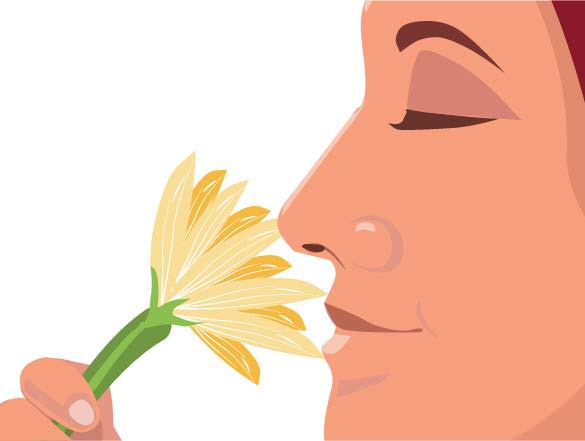11.60 原免疫系统
Section outline
-
What is your nose good for?
::你的鼻子有什么用吗?Your nose does a lot of work for you! Obviously, it helps you breathe and provides your sense of smell . But you might not realize that your nose also helps to fight off disease.
::你的鼻子为你做了很多工作!显然,它能帮助你呼吸和提供你的嗅觉。但你可能不知道你的鼻子也有助于战胜疾病。The Immune System's First Line of Defense
::免疫系统第一防线It is the immune system's job to protect the body. Your body has many ways to protect you from . Your body’s defenses are like a castle. The outside of a castle was protected by a moat and high walls. Inside the castle, soldiers were ready to fight off any enemies that made it across the moat and over the walls. Like a castle, your body has a series of defenses. Only pathogens that get through all the defenses can harm you.
::保护身体是免疫系统的职责。你的身体有许多方法可以保护你免受伤害。你的身体的防御就像城堡一样。城堡的外侧有护城河和高高墙保护。在城堡内,士兵们准备与任何敌人作战,这些敌人越过护城河和高墙。像城堡一样,你的身体有一系列防御。只有通过所有防城线的病原体才能伤害你。The first line of defence includes both physical and chemical barriers that are always ready and prepared to defend the body from infection. Pathogens must make it past this first line of defense to cause harm. If this defense is broken, the second line of defense within your body is activated.
::第一道防线包括身体和化学屏障,这些屏障总是准备就绪,准备保护身体免受感染。病原体必须超越第一道防线,才能造成伤害。如果防线被打破,身体内的第二道防线就会启动。Your body’s first line of defense is like a castle’s moat and walls. It keeps most pathogens out of your body. This is a non-specific type of defense, in that it tries to keep all pathogens out. The first line of defense includes different types of barriers. Being the "first line", it starts with the skin. The first line also includes tears, mucus , cilia , stomach acid, urine flow, and friendly bacteria .
::你的身体的第一道防线就像城堡的护城河和防城墙一样。它把大部分病原体从你的身体中排除出来。这是一种非特定类型的防御,因为它试图将所有病原体都排除出去。 第一道防线包括了不同类型的屏障。 作为“第一线 ” , 它从皮肤开始。 第一行还包括眼泪、黏液、仙梨、胃酸、尿液流和友好细菌。Skin and Mucous Membranes
::皮肤和粘膜膜The skin is a very important barrier to pathogens. The skin is the body’s largest organ . In adults, it covers an area of about 16 to 22 square feet! The skin is also the body’s most important defense against disease. It forms a physical barrier between the body and the outside world. The skin has several layers that stack on top of each other ( Figure ). The outer layer is tough and waterproof. It is very difficult for pathogens to get through this layer of skin.
::皮肤是病原体的一个非常重要的屏障。 皮肤是身体最大的器官。 在成人中,皮肤覆盖面积约为16至22平方英尺。 皮肤也是身体对抗疾病的最重要防御手段。 它在身体和外部世界之间形成了物理屏障。 皮肤有几层相互叠叠的层( 图 ) 。 外层是坚硬的,防水的。 病原体很难穿过这一层的皮肤。This drawing shows that the skin has many layers. The outer layer is so tough that it keeps out most pathogens.
::这个图示显示皮肤有多个层。 外层很坚硬, 大部分病原体都被遮住了 。The mouth and nose are not lined with skin. Instead, they are lined with mucous membranes . Other organs that are exposed to the outside world, including the lungs and stomach, are also lined with mucous membranes. Mucous membranes are not tough like skin, but they have other defenses.
::口和鼻不与皮肤连在一起,而是与粘膜连在一起。 其他接触外部世界的器官,包括肺和胃,也与粘膜连在一起。 粘膜不像皮肤那么坚硬,但有其他防御手段。One defense of mucous membranes is the mucus they release. Mucus is a sticky, moist substance that covers mucous membranes. Most pathogens get stuck in the mucus before they can do harm to the body. Many mucous membranes also have cilia. Cilia in the lungs are pictured below ( Figure ). Cilia are tiny finger-like projections. They move in waves and sweep mucus and trapped pathogens toward body openings. When you clear your throat or blow your nose, you remove mucus and pathogens from your body.
::粘粘膜膜的一种防御是它们释放的粘结膜。 粘结膜是一种粘粘的潮湿物质, 覆盖粘结膜。 大多数病原体在它们伤害身体之前就卡在粘结膜中。 许多粘结膜也有粘结膜。 肺部的Cilia在下面( 图 ) 。 Cilia 是小手指相似的预测。 它们以波浪移动, 扫扫扫粘结和困住的病原体进入身体开口。 当你清除喉咙或打鼻部时, 你就会清除体内的粘结和病原体。This is what the cilia lining the lungs look like when they are magnified. Their movements constantly sweep mucus and pathogens out of the lungs. Do they remind you of brushes?
::当肺部膨胀的时候,肺部的结膜就是这样的。肺部的肌肉和病原体经常被扫出肺部,难道他们提醒你刷子吗?Chemicals
::化学品化学品Most body fluids that you release from your body contain chemicals that kill pathogens. For example, mucus, sweat , tears, and saliva contain enzymes called lysozymes that kill pathogens. These enzymes can break down the cell walls of bacteria to kill them.
::从身体中释放出来的大多数体液中含有杀死病原体的化学物质。例如,粘液、汗水、眼泪和唾液含有杀死病原体的酶。这些酶可以破碎细菌的细胞壁来杀死病原体。The stomach also releases a very strong acid, called hydrochloric acid. This acid kills most pathogens that enter the stomach in food or water. Urine is also acidic, so few pathogens can grow in it.
::胃中还释放出一种非常强的酸,叫做盐酸。 这种酸杀死了大部分进入胃中的食物或水的病原体。 尿也是酸性的,因此很少有病原体能在胃中生长。Helpful Bacteria
::帮助细菌You are not aware of them, but your skin is covered by millions (or more!) of bacteria. Millions more live inside your body. Most of these bacteria help defend your body from pathogens. How do they do it? They compete with harmful bacteria for food and space. This prevents the harmful bacteria from multiplying and making you sick.
::你不了解这些细菌,但你的皮肤上还有数百万细菌,还有数百万人生活在你的身体里。这些细菌大多有助于保护你的身体不受病原体的侵扰。它们是如何做到的?它们与有害细菌竞争食物和空间,防止有害细菌的繁殖,使你生病。Summary
::摘要-
Your body’s first line of defense includes the skin and other barriers that keep pathogens out of your body.
::身体的第一道防线包括皮肤和其他屏障,这些屏障使病原体远离身体。 -
Most body fluids that you release from your body contain chemicals that kill pathogens.
::你从体内释放出来的体液 大多含有杀死病原体的化学物质
Explore More
::探索更多Use the resource below to answer the questions that follow.
::利用以下资源回答以下问题。-
Introduction To How The Immune System Works
at
(3:16)
::《免疫系统如何运作》(3:16)导言
-
How do external barriers help our immune system?
::外部壁垒如何帮助我们的免疫系统? -
Where is mucus used as a barrier?
::粘液在哪里被用作屏障? -
How do some bacteria aid our immune system?
::一些细菌如何帮助我们的免疫系统?
Review
::回顾-
How does your skin protect you from pathogens?
::你的皮肤如何保护你免受病原体感染? -
What is mucus? What are mucous membranes?
::粘膜是什么 粘膜是什么 -
How is mucus helpful?
::粘液怎么有用? -
How are lysozymes helpful?
::淋巴素怎么有用? -
How do helpful bacteria defend your body?
::帮助细菌如何保护你的身体?
-
Your body’s first line of defense includes the skin and other barriers that keep pathogens out of your body.


